
Periodontal Risk Management Model
Due to the multifactorial nature of periodontal disease, identifying, assessing and managing risk factors are integral to successful therapy.

Periodontal disease involves bacterial infections with subgingival pathogens responsible for the disease process. This subgingival infection, which is specific and unique to the oral cavity, is not sufficient for tissue destruction to take place. An increased host inflammatory response to the bacterial infection, as well as particular risk factors that modulate the host’s inflammatory response, are necessary for the disease to manifest clinically.1–3 This triad of periodontal infection, host inflammatory response and associated risk factors speaks to the multifactorial nature of periodontal disease (Figure 1). Treatment should therefore address all components of the multifactorial triad.
The establishment of periodontal disease as multifactorial, and recognition that, in addition to subgingival infection, specific risk factors are necessary for disease to develop, have placed considerable importance on risk assessment. This has resulted in a paradigm shift in the diagnosis and treatment of a disease once understood to be related only to the accumulation of dental plaque.4 Thus, current thinking on periodontal treatment and long-term management has shifted from exclusively controlling plaque to a multidimensional approach.
In this approach, the patient’s oral status is integrated to his or her general health status, presence of specific risk factors, and behavioral contributory factors. The approach is dynamic in nature because it requires regular monitoring and evaluation of oral findings and general health, and a reduction or adequate management of existing risk factors. Therapeutic goals are evaluated periodically, and changes in therapy made accordingly to control risk factors and achieve and sustain long-term periodontal health (Figure 2).
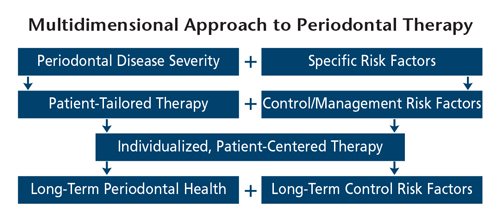
Under this new approach, the role of risk assessment is considered essential for good clinical practice. Thus, the contemporary view in treatment and management of periodontal disease is multidimensional — that is, the patient’s level of disease, and its signs and symptoms, are evaluated in the context of patient’s overall health and presence of specific risk factors. An individualized, patient-centered treatment regime is developed and carried out. Although the role that risk factors play in the development of periodontal disease is widely recognized, and growing evidence suggests a link between periodontal health and systemic health, this knowledge is still underutilized by most dental practitioners. More needs to be done to identify, mitigate and manage periodontal risk factors, as this will offer considerable benefits to patients’ oral health.
The use of formal risk assessment tools will assist clinicians in identifying patients at greatest risk for periodontal disease, as well as those in need of targeted interventions to prevent or reduce the severity of disease. Models have been proposed to help dental professionals obtain and integrate risk assessment information for use in diagnosis, treatment planning and therapy. Toward that end, this article provides a simple, evidence-based model for the comprehensive management of periodontal risk factors that’s easy to implement in clinical practice, as this remains a major component of successful long-term periodontal care.
MODELS FOR CLINICAL PRACTICE
In recent years, numerous computer-generated risk assessment models have been proposed to assist oral health professionals with estimating a patient’s risk of periodontal disease, and from which risk assessment may be implemented in clinical practice. Internet-based systems are available that quantify risk for periodontitis and periodontal disease severity and extent, and generate treatment recommendations and interventions. They typically gather clinical and radiographic data that are combined with medical and risk factor information. After data analysis, risk and disease scores may be generated, along with suggested treatment modalities.5,6 Other Web-based tools use algorithms to calculate risk based on factors such as: age; history of smoking, diabetes and periodontal surgery; pocket depth; furcation involvement; alveolar bone height; and vertical bone loss.6 Risk scores increase depending on history of periodontal surgery, tobacco use, and the presence of chronic disease.7
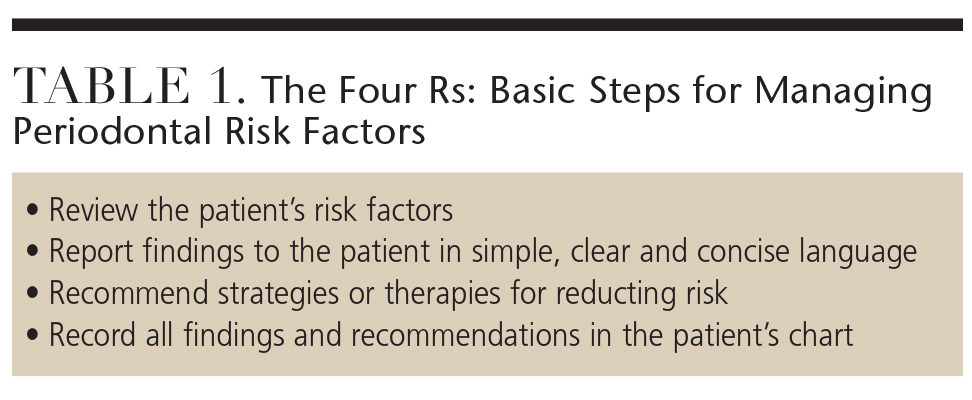
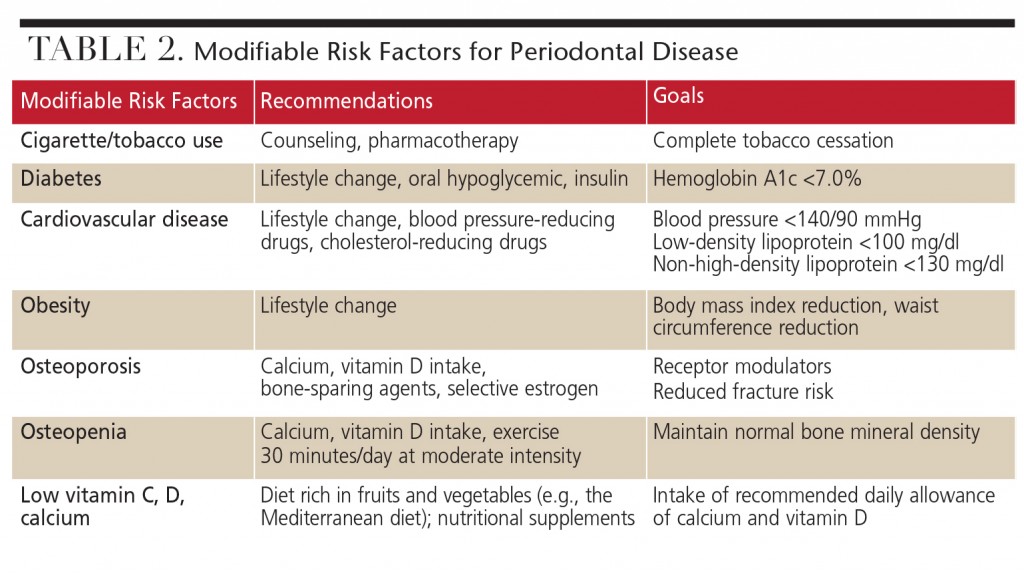 Another periodontal risk assessment tool uses a functional diagram to evaluate the risk for progression of periodontal disease.8 It considers the percentage of bleeding-on-probing sites; prevalence of residual pockets greater than 4 mm; loss of teeth (excluding third molars); loss of periodontal support relative to the patient’s age; systemic and genetic conditions; and environmental factors (e.g., smoking). The contribution of each risk factor domain is arbitrarily weighed to yield an overall risk score, and a visual representation of the patient’s individual risk of progression of periodontal disease. This method has not been validated prospectively, however, and its use is limited to a patient discussion and motivational tool.
Another periodontal risk assessment tool uses a functional diagram to evaluate the risk for progression of periodontal disease.8 It considers the percentage of bleeding-on-probing sites; prevalence of residual pockets greater than 4 mm; loss of teeth (excluding third molars); loss of periodontal support relative to the patient’s age; systemic and genetic conditions; and environmental factors (e.g., smoking). The contribution of each risk factor domain is arbitrarily weighed to yield an overall risk score, and a visual representation of the patient’s individual risk of progression of periodontal disease. This method has not been validated prospectively, however, and its use is limited to a patient discussion and motivational tool.
The American Academy of Periodontology’s (AAP) self-assessment tool uses a simple five-item questionnaire to gather patient data regarding brushing and flossing behavior, dental visits, and history of bleeding gums, smoking or family members with periodontal disease. Using an algorithm, the answers are combined and categorize patients as “low risk” or “at risk” of periodontal disease. This self-assessment system enables the estimation of disease risk for the general population.9
SIMPLIFIED MODEL FOR MANAGING RISK FACTORS
As explained here, a simple, evidence-based model for implementing periodontal disease risk assessment and management can be altered as therapies and goals evolve. This model can easily be integrated into clinical practice and applied at each dental visit, and it does not require additional appointment time. These steps — review, report, recommend and record, collectively referred to as the “Four Rs” — are already part of the periodic dental/periodontal examination (Table 1). While not new, this model is organized in a coherent sequence that ensures a concrete outcome — and it can be implemented into practice without reducing time spent on other components of dental care, thus enhancing the scope of the visit.
REVIEW
The first step in managing patients’ risk factors is to identify them. Presence of major risk factors may be elicited on patient questionnaires that include a section for medical conditions (systemic risk factors), including diabetes, cardiovascular disease, obesity, metabolic syndrome, osteoporosis and autoimmune diseases. Information on the presence of any of these diseases should include current therapy and compliance with prescribed therapy. Questions regarding the major risk factors for periodontal disease (e.g., smoking, diabetes, cardiovascular disease, obesity and osteoporosis) should be integrated into existing patient questionnaires. Dietary habits and the use of nutritional supplements and alcohol should also be recorded. Information obtained in the questionnaire should be reviewed with the patient, with the process repeated at every visit. Patients should be assigned an individual score based on the presence of one or more major risk factors. Risk scoring should be repeated at every visit for patients with two or more major risk factors.
key takeaways
- Recognition that, in addition to subgingival infection, specific risk factors are necessary for periodontal disease to develop has placed considerable importance on risk assessment — and this has led to a multidimensional approach to periodontal therapy and management.
- In this multidimensional approach, the patient’s oral status is integrated to his or her general health status, presence of specific risk factors, and behavioral contributory factors.
- By monitoring and managing risk factors for periodontal disease, dental professionals can improve dental and medical outcomes by focusing on early identification and proactive, targeted interventions.
- The periodontal risk assessment model proposed in this article builds on procedures that are already part of a routine dental visit.
- This approach allows for individualized dental/periodontal treatment in a patient-centered holistic model that includes dental, medical and lifestyle/behavioral factors.
REPORT
The report step focuses on making patients aware of their risk factors and risk profile. Identifying risk factors as early as possible in the treatment process contributes to patient awareness of a problem and the need for change. Patients should be educated about the factor(s) for which they are positive and the potential impact on periodontal conditions and treatment outcomes. Summarize this information in simple language that is easily understood. This is a crucial step, as it helps establish and reaffirm the clinician/patient relationship and builds trust.
During this report, clinicians should provide patients with information about the oral-systemic link that explains the interconnectedness of oral and general health. Providing this information leads to the recommendation phase, which discusses what patients can and/or should do in order to reduce their risk for periodontal disease.
RECOMMEND
The next step is to recommend strategies for reducing risk. The first line of therapy should include reduction or management of underlying risk factors. Using brief language, explain to patients the importance of risk reduction and empower them with strategies that will assist in achieving this goal. Behavior modification success hinges on the dentists’ participation and attitude, as patients look to dentists for guidance and will respond favorably when clinicians set clear expectations for risk factor reduction and lifestyle changes.
A patient identified with major risk factors should enter clinical management regimes. The dentist should establish and communicate the goals of periodontal treatment, encourage lifestyle modification (as appropriate), and involve/refer to additional health professionals as necessary. For example, in the case of a patient with uncontrolled diabetes, indicate the need for improved glucose control. If a patient smokes, stress the importance of smoking cessation. Such recommendations go hand in hand with instructions in better self-care, daily oral hygiene and improved diet (Table 2 provides a summary). The recommend portion need not to take more than few minutes of chairtime — and that’s time well spent in ensuring treatment success.
RECORD
After reviewing, reporting and recommending, the final step is recording. Oral health professionals should record patients’ risk factors in their charts. Recommendations about how to eliminate modifiable risk factors and manage nonmodifiable risk factors should also be documented at this time.
MODIFIABLE RISK FACTORS
As part of periodontal disease risk assessment, clinicians need to identify patients’ modifiable risk factors. Systemic risk factors include diabetes, obesity, cardiovascular disease, metabolic syndrome, osteoporosis, osteopenia, and low dietary intake of nutrients, such as vitamin C, D and calcium. Behavioral risk factors include smoking, while psychosocial risk factors include elevated stress levels. These risk factors can be changed or eliminated, and effective treatment strategies will aid in these efforts. Clinicians need to be thorough when speaking with patients about current methods for managing risk factors, and patient charts should be updated at every visit with information detailing the current status of risk factors.
CIGARETTE/TOBACCO CESSATION
Cigarette smoking is one of the most significant risk factor associated with periodontal disease incidence, severity, progression and negative treatment outcomes. Oral health professionals have a moral obligation to engage in tobacco cessation strategies, and to encourage all patients who smoke to quit.
Among patients who smoke cigarettes or use tobacco, the most important factor in quitting is self-motivation. A recommendation from a trusted clinician goes a long way in helping spark motivation for change. To better help clinicians assist their patients with smoking cessation, the U.S. Public Health Services’ “Clinical Practice Guideline for Treating Tobacco Use and Dependence,”10 recommends the following:
- Ask all patients about tobacco
- Advise patients to quit
- Assess willingness to quit
- Assist with counseling/pharmacotherapy
- Arrange for follow-up within the first week of the quit date
Pharmacotherapy may be recommended to patients who need additional support to achieve smoking cessation. Effective adjuncts include nicotine replacement therapies, such as order bupropion or varenicline. Data suggest the latter pharmacotherapy is most effective at achieving smoking cessation.11,12
DIABETES PREVENTION AND TREATMENT
Diabetes and prediabetes are important risk factors for periodontal disease. Identifying undiagnosed diabetes or prediabetes is important, as interventions have been shown to reduce the development of diabetes and could potentially reduce the onset or severity of a periodontal disease.13,14 Several reports recommend screening for diabetes in the dental setting. The American Diabetes Association recommends that individuals with diabetes achieve a goal hemoglobin A1c of <7.0%. For patients with diabetes and periodontal disease, glucose control and periodontal disease management are extremely important.15
A joint report from the AAP and European Federation of Periodontology16 found that periodontal health plays an important role in the management of diabetes. The report outlines clinical recommendations for dental professionals to use when treating patients with diabetes, and emphasizes the importance of an annual comprehensive periodontal evaluation as part of an effective diabetes management program. This consensus report is based on a large body of scientific evidence that suggests periodontal health may be helpful in controlling diabetes.16
CARDIOVASCULAR DISEASE
There is evidence to suggest that cardiovascular disease is associated with periodontal disease.17 Oral health professionals should review the therapeutic regimens and medication histories of all patients with cardiovascular disease. Important goals to consider in patients with diagnosed cardiovascular disease are controlling blood pressure, cholesterol and lipids. Current guidelines for blood pressure in patients with diabetes or cardiovascular disease suggest a target of 140/90 mmHg.18 Lipid lowering therapy is another important component of cardiovascular disease prevention and treatment. In general, the goal of lipid lowering therapy is a total cholesterol <200 mg/dl, and non-high-density lipoprotein cholesterol <130 mg/dl.
OBESITY![]()
Obesity (body mass index or BMI >30 kg/m) is an important risk factor for periodontal disease and diabetes alike. Adipose tissue produces and secretes TNF-a, IL-1B and IL-6, which have effects on adipose and systemic tissues. These adipose tissue cytokines enhance insulin resistance in systemic tissues through serine phosphorylation of the IRS-1 receptor, thereby blocking insulin signaling. Obesity, and especially abdominal obesity, is a significant risk factor for insulin resistance, and abdominal adipose tissue is considered to be the most insulin resistant. Population studies show that abdominal fat is more closely associated with periodontal disease, diabetes and cardiovascular disease than subcutaneous fat and BMI.
The specific category of abdominal obesity is shown in Table 3, which is easily assessed by simply measuring waist circumference. Even modest goals to reduce caloric intake and increase physical exercise can lead to reductions in weight and waist circumference. Counting calories and reducing intake of high-calorie beverages are helpful weight-loss strategies and also reduce the risk for dental and root caries. The Mediterranean diet, which is rich in fruit and vegetable intake, has been associated with positive health parameters. For exceedingly obese individuals, bariatric surgery is an additional weight-control alternative that may be worth exploring.
OSTEOPOROSIS AND OSTEOPENIA
Osteoporosis is an important risk factor for periodontal bone loss, tooth loss and implant failure.19 Management of osteoporosis includes lifestyle measures, adequate intake of calcium and vitamin D, weight-bearing exercise, and preventing falls. Based on a patient’s condition, age, health history and other factors, it may be advisable for individuals to begin a regimen of dietary supplements. If warranted, and based on current recommendations,20 adults age 50 and younger may be advised to take 1000 mg calcium and 400 IU to 800 IU of vitamin D daily. Women between ages 51 and 70 should take 1200 mg calcium and 400 IU to 800 IU of vitamin D each day. Men ages 51 to 70 are advised to take 1000 mg calcium and 400 IU to 800 IU vitamin D per day. For men and women older than 70, 1200 mg calcium and 800 IU vitamin D should be taken daily. Pharmacotherapy includes bone sparing agents, bisphosphonates (alendronate, ibandronate and risedronate), and selective estrogen receptor modulators. Due to the risk of bisphosphonate-related osteonecrosis of the jaw, patients on bisphosphonate therapy should be closely monitored when an invasive dental procedure, such as oral surgery, is indicated.
Osteopenia, a reduction in bone density below the normal value for age and gender, is a risk factor for alveolar bone loss. Management of mild and moderate osteopenia includes adequate intake of calcium and vitamin D, and regular, moderate weight-bearing exercise.
ADDITIONAL LIFESTYLE FACTORS![]()
Patients should be questioned regarding their daily intake of vitamin C, vitamin D and calcium. Table 4 shows the recommended daily amounts for vitamin C, and Table 5 shows the recommendations for calcium and vitamin D.20,21
Excessive daily stress and poor coping strategies are risk factors for periodontal disease, cardiovascular disease and other conditions. As such, oral health professionals should recommend that patients experiencing highstress seek professional help and implement self-help measures. These include good nutrition, avoiding excess stimulants (e.g., caffeine and alcohol), daily exercise, resilience strategies and stress-coping mechanisms. The goal is to reduce the negative physical effects of daily stress.
GENETIC SUSCEPTIBILITY![]()
Genetic susceptibility to periodontal disease has been proposed in studies conducted on twins and evaluation of candidate genes.22–24 Recently, functional polymorphisms in the IL-1B gene have been found to be associated with moderate and severe periodontitis in different ethnic groups.22 Simple chairside tests are available to ascertain genetic risk factors for periodontal disease. These tests are important new tools that can help identify high-risk patients and assist clinicians in developing individualized treatment plans.
SUMMARY
Dental professionals have dedicated their careers to improving the oral health of their patients. This proposed periodontal risk assessment model builds on procedures that are already part of a routine dental visit. It enables clinicians to help monitor and improve outcomes without the need to increase chairtime or appointment lengths. Rather, this model of risk factor monitoring and management provides dental professionals with the opportunity to improve dental and medical outcomes in the general population — and especially among high-risk populations — by focusing on early identification and proactive, targeted interventions. Most importantly, it allows for individualized dental/periodontal treatment in a patient-centered holistic model that includes dental, medical and lifestyle/behavioral factors.
References
- Genco RJ, Borgnakke WS. Risk factors for periodontal disease. Periodontol 2000. 2013;62:59–94.
- Genco RJ. Current view of risk factors for periodontal diseases. J Periodontol. 1996;67(Suppl 10):1041–1049.
- Kinane DF, Marshall GJ. Periodontal manifestations of systemic disease. Aust Dent J. 2001;46:2–12.
- Grossi SG. Assess periodontal risk. Dimensions of Dental Hygiene. 2013;11(10):58–62.
- Page RC, Martin JA, Loeb CF. The Oral Health Information Suite (OHIS): its use in the management of periodontal disease. J Dent Educ. 2005;69:509–520.
- Page RC, Krall EA, Martin J, Manci L, Garcia RI. Validity and accuracy of a risk calculator in predicting periodontal disease. J Am Dent Assoc. 2002;133:569–576.
- Page RC, Martin J, Krall EA, Mancl L, Garcia R. Longitudinal validation of a risk calculator for periodontal disease. J Clin Periodontol. 2003;30:819–827.
- Lang NP, Tonetti MS. Periodontal risk assessment (PRA) in supportive periodontal therapy (SPT). Oral Health Prev Dent. 2003;1:7–16.
- American Academy of Periodontology. Test Your Gums Quiz. Available at: https://www.perio.org/sites/loveyourgums/gums-101.php. Accessed November 19, 2015.
- Clinical Practice Guideline Treating Tobacco Use and Dependence: 2008 Update Panel, Liaisons, and Staff. A clinical practice guideline for treating tobacco use and dependence: 2008 update. A US Public Health Service report. Am J Prev Med. 2008;35:158–176.
- Mahmoudi M, Coleman CI, Sobieraj DM. Systematic review of the cost-effectiveness of varenicline vs bupropion for smoking cessation. Int J Clin Pract. 2012;66:171–182.
- Jorenby DE, Hays JT, Rigotti NA, et al. Efficacy of varenicline, an alpha4beta2 nicotinic acetylcholine receptor partial agonist, vs placebo or sustained-release bupropion for smoking cessation: a randomized controlled trial. JAMA. 2006;296:56–63.
- Corbella S, Francetti L, Taschieri S, De Siena F, Fabbro MD. Effect of periodontal treatment on glycemic control of patients with diabetes: A systematic review and meta-analysis. J Diabetes Investig. 2013;13;4:502–509.
- Simpson TC, Needleman I, Wild SH, Moles DR, Mills EJ. Treatment of periodontal disease for glycaemic control in people with diabetes. Cochrane Database Syst Rev. 2010;12: CD004714.
- Borgnakke WS, Ylostalo PV, Taylor GW, Genco RJ. Effect of periodontal disease on diabetes: a systematic review of epidemiological observational studies. J Periodontol. 2013:84(Suppl 4):S135–S152.
- Chapple ILC, Genco RJ; working group 2 of the joint EFP/AAP workshop. Diabetes and periodontal diseases: consensus report of the Joint EFP/AAP Workshop on Periodontitis and Systemic Diseases. J Periodontol. 2013;84(Suppl 4):S106–S112.
- Friedewald VE, Kornman KS, Beck JD, et al. The American Journal of Cardiology and Journal of Periodontology Editors’ Consensus: periodontitis and atherosclerotic cardiovascular disease. Am J Cardiol. 2009;104:59–68.
- American Diabetes Association. Standards of medical care in diabetes—2013. Diabetes Care. 2013;36:S11-S66.
- Wactawski-Wende J. Periodontal diseases and osteoporosis: association and mechanisms. Ann Periodontol. 2001;6:197–208.
- Institute of Medicine, Food and Nutrition Board. Dietary Reference Intakes for Calcium and Vitamin D. Washington, DC: National Academies Press; 2010.
- Institute of Medicine, Food and Nutrition Board. Dietary Reference Intakes for Vitamin C, Vitamin E, Selenium, and Carotenoids. Washington, DC: National Academies Press; 2000.
- Wu X, Offenbacher S, López NJ, et al. Association of interleukin-1 gene variations with moderate to severe chronic periodontitis in multiple ethnicities. J Periodont Res. 2015;50(1):52–61.
- Hacker BM, Roberts FA. Periodontal disease pathogenesis: genetic risk factors and paradigm shift. Pract Proced Aesthet Dent. 2005;17:97–102.
- Baker PJ, Roopenian DC. Genetic susceptibility to chronic periodontal disease. Microbes Infect. 2002;4:1157–1167.


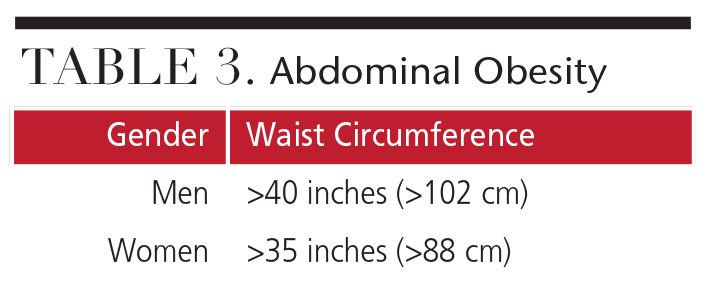
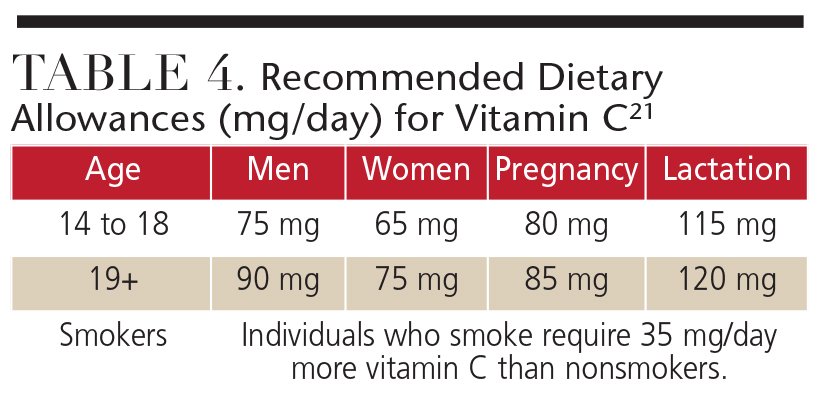
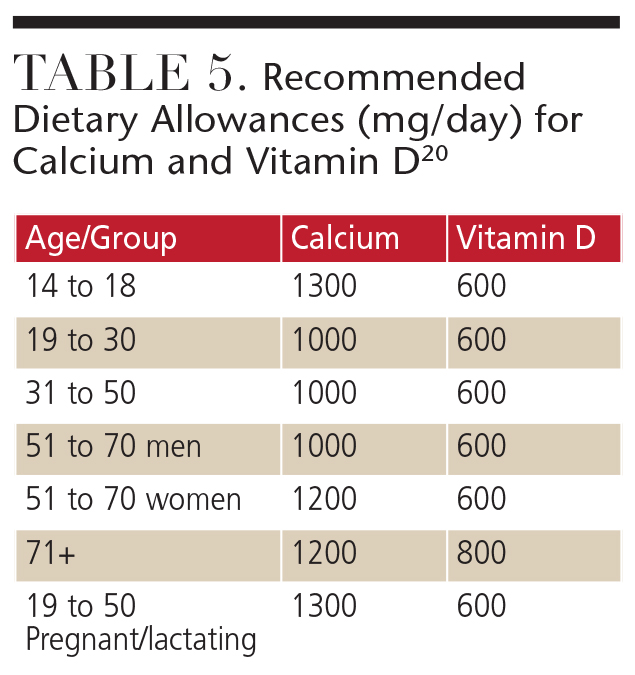

This is an awesome article! Enjoyed reading it. Thank ou very much Dr.Sara.